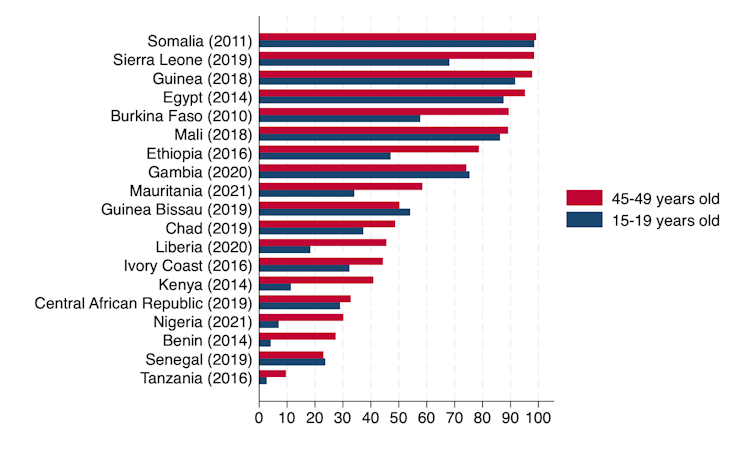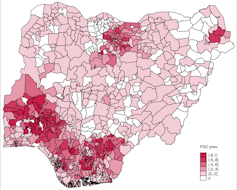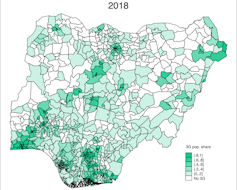How to republish
Read the original article and consult terms of republication.
Excision and other forms of female genital mutilation: could Internet help to campaign against such practices?
By Daniel Pérez-Parra, PhD Candidate in Economics - Université Gustave Eiffel (Laboratoire Érudite).

Photo credits : Epictura - Kehindeolufemi 587761
A study conducted in Nigeria suggests that, in regions of the world where excision and other forms of female genital mutilation are still practised, the emergence of high-speed Internet, especially in previously remote areas, could have a liberating influence on the sexual behaviour of women and hence help to reduce such practices.
In the world, particularly in Africa, female genital mutilation (FGM) - also known as female circumcision - affects more than 4 million women and girls each year.
In total, there are more than 230 million women and girls living in the world today who have undergone FGM, according to figures announced by UNICEF in 2024. It is estimated that approximately 60,000 women living in France have been circumcised.
These mutilations can take the form of partial or total removal - we commonly use the term excision - of the clitoral glans and/or the labia minora of the vulva, infibulation (i.e. narrowing of the vaginal opening), or other harmful procedures to the female genitalia carried out for non-medical purposes, according to the definition by the World Health Organization (WHO). All these forms of mutilation are associated with an increased health risk to the women concerned and can even result in death, as stated by WHO.
Percentage of women having undergone FGM in sub-Saharan Africa

Because FGM is generally carried out before the age of 15 years, the difference observed between the two age groups studied (girls aged 15 to 19 and women aged 45 to 49) reflects how the practice has evolved over time.
How Internet is changing opinion on female genital mutilation
Despite international campaigns to eradicate these practices, deep-rooted in certain cultures, they still persist in many communities. Could they evolve in the face of rapid modernisation and the increasing availability of high-speed Internet?
Our research suggests that more widespread access to Internet, alongside initiatives calling into question the stigma that supports FGM, could become a powerful strategy to campaign against such practices.
A study conducted in Nigeria
Our study examines the role of fast Internet in influencing the prevalence and acceptance of FGM in Nigeria, a country where this practice remains commonplace among a number of ethnic groups.
All our estimations are based on the Nigerian Demographic and Health Survey, a nationally representative database containing information collected from more than 30,000 people throughout Nigeria.
Prevalence of FGM across all Nigerian municipalities in 2018

The crimson colour represents the percentage of females aged 15 to 49 years having undergone mutilation. This ranges from 0 to over 80%. Source : Nigerian Demograhic and Health Survey.
In Nigeria, FGM is traditionally seen as a way of reducing sexual desire in women and discouraging them from engaging in premarital or extramarital sexual relations, behaviour that carries a stigma in many communities. It is important to point out that Nigeria is a federal republic in which only certain states have passed legislation specifically against female genital mutilation.
Furthermore, being the most populous country in Africa and the largest mobile phone market on the continent, with more than 170 million mobile connections in 2019, this nation provides an exceptional context in which to study how technology and cultural practices interact.
A reduction in FGM support and practice, particularly in rural areas
However, the arrival of high-speed Internet in previously remote regions exposes these communities to worldwide cultures and to the diversity of expressions of female identity.
Our studies suggest that this exposure helps to remove the stigmas attached to premarital and extramarital sexual behaviour, hence undermining the arguments in favour of FGM. As a reminder, such behaviour is the main reason for FGM practices in many countries.
Percentage of people covered by Nigeria’s 3G network in 2018, by municipality

The denser the green, the higher the percentage of people exposed to 3G communication. Source : Global System for Mobile Communications Association, Nigeria.
In addition, organisations such as UNICEF increasingly use online platforms to conduct anti-FGM campaigns, which benefit from the wider exposure that comes with Internet access.
To assess the impact of fast Internet, we compared populations that have access with those that do not, taking advantage of the gradual roll-out of 3G networks in Nigeria, the principal means of access to high-speed Internet in sub-Saharan Africa.
Using 3G coverage maps based on geospatial data, we were able to determine which Nigerian villages and neighbourhoods benefit from 3G communication.
By using advanced statistical methods to isolate the impact of 3G from other factors, we observed that Internet access significantly reduces both the prevalence of FGM (a 55% decrease in rural areas and 30% for Nigeria as a whole) and support for this practice, particularly in rural areas.
When Internet contributes to liberating sexuality
To understand the mechanisms behind these changes, we studied the impact of Internet access on stigmatised sexual behaviours and cultural norms. Our results show that access to Internet is associated with an increase in premarital and extramarital sexual relations, and a higher number of sexual partners per lifetime, especially for women.
These results support the idea that Internet access leads to a broader cultural transition towards permissive behaviour, rendering FGM increasingly redundant.
We also analysed the impact of online anti-FGM campaigns on this decline, again drawing on the Nigerian Demographic and Health Survey database. In particular, we explored the 2018 UNICEF campaign carried out for the International Day of the Girl on 11 October, one of the most important online anti-FGM campaigns conducted that year.
Surprisingly, our analysis revealed that the campaign did very little to reduce support for FGM, although we can consider that, overall, awareness-raising initiatives among the population do play a part.
This observation suggests that the decline is due mainly to a broader cultural change that reduces the stigmatisation of permissive sexual behaviour, rather than to the actual content of the campaign. We also ruled out factors such as income growth and migration as alternative explanations of the impact of Internet access on FGM.
These results have significant implications. Broadening access to Internet, alongside initiatives that directly question the stigma behind FGM, could become an effective approach to reducing this practice.
However, the increased cultural uniformity that comes with Internet exposure could have unexpected consequences, and these need to be explored further by future research.
Identity card of the article
Original title: | Excisions : comment un meilleur accès à Internet pourrait aider à combattre les mutilations génitales féminines. |
Author: | Daniel Pérez-Parra |
Publisher: | The Conversation France |
Collection: | The Conversation France |
Licence : | This article is republished from The Conversation France under Creative Commons licence. Read the original article. An English version was created by Hancock & Hutton for Université Gustave Eiffel and was published by Reflexscience under the same license. |
Date: | April 9, 2025 |
Languages: | French and english |
Key words: | Africa, « Et surtout la santé ! » (ESLS), internet, female genital mutilation, Nigeria, southern countries, women's health, sexuality. |

![[Translate to English:] Licence creative commons BY-SA 4.0 [Translate to English:] Licence creative commons BY-SA 4.0](https://reflexscience.univ-gustave-eiffel.fr/fileadmin/ReflexScience/Accueil/Logos/CCbySA.png)